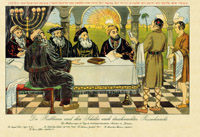By Ben Harris, JTA News & Features
NEW YORK (JTA) — Why is this Passover different than all other Passovers?
On most Passovers, it is the liberal Jewish denominations that seek to reinterpret the holiday traditions, often viewing them through the prism of contemporary struggles for civil rights and environmental preservation.
But this Passover, it is the more conservative wings of the Jewish community that are offering a fresh read on the Haggadah.
Both the Orthodox Union and the Schechter Institute of Jewish Studies, a spiritual home of some traditionalists within the Conservative movement, are touting new offerings in time for the holiday.
The OU has released a new Haggadah based on the writings of the late Rabbi Joseph Soloveitchik, while Schechter has put out two new volumes, including one with a lengthy survey of ancient Passover rituals.
“The Haggadah has been reinterpreted in every generation,” said Dr. Joshua Kulp, who authored the historical essay at the back of The Schechter Haggadah. “I think that by studying the origins we come to understand where the customs that we’re observing today and where the text comes from. For me, it brings greater meaning to the text.”
With upwards of three-quarters of American Jews attending a seder — more than who light Hanukkah candles or fast on Yom Kippur, according to the most recent National Jewish Population Survey — Passover is likely the most observed of Jewish holidays. So it’s hardly a surprise that the Haggadah, the traditional guidebook for the evening, is among the most frequently reinvented.
But while past years have seen volumes produced that read the Exodus story through a distinctly contemporary lens, the new spate of Haggadot is far more oriented toward traditional sources, in particular excavating certain writings, themes, artworks and rituals that have been cast off or forgotten over the years.
The Soloveitchik Haggadah, titled The Seder Night: An Exalted Evening, is the first production of the newly minted OU Press, established this year in part to disseminate Soloveitchik’s unpublished writings and lectures.
Edited by Rabbi Menachem Genack, the OU’s head of kashrut supervision, the volume culls Soloveitchik’s lectures, notes and teachings to present a dense and learned commentary on the seder’s various components.
But while Soloveitchik is revered in part for breathing life into Modern Orthodoxy, with its marriage of ritual observance and engagement with the broader world, the Haggadah is a pointed, if inadvertent, rejoinder to those who would re-imagine the seder in purely contemporary terms.
“The Rav’s teachings emphasized the centrality of Torah study to the seder night,” Genack writes in the introduction.
According to Genack, part of the challenge in producing the Haggadah was in making the famously erudite Soloveitchik accessible. Readers will ultimately decide if he succeed, but the Haggadah is not for the faint of heart. Many pages have but a few lines of text accompanied by lengthy commentary.
By contrast, the two Schechter Haggadot are both heavily infused with artwork. Kulp’s Haggadah includes three sections: The traditional seder night service; a collection of more than 100 illustrations collected by Schechter President Rabbi David Golinkin; and a historical commentary by Kulp, a professor of Talmud and Jewish law.
Some of the old illustrations were intended help participants observe particular rituals of the seder night. For instance, the tradition of reclining at the table was foreign to European Jews who were accustomed to eating at a table, unlike earlier Jews who may have sat on the floor or on cushions, which more easily lent themselves to the practice. In one European Haggadah from the 15th century, a man is depicted lying awkwardly on a table.
“The history of the night is also the history of the books and the pictures that make up the night,” Kulp said. “Those things, I think, go together.”
The other Schechter release, The Lovell Haggadah, was produced by rabbi and artist Matthew Berkowitz of Boca Raton, Fla. Berkowitz spent more than four years producing a new translation and commentary in addition to original artworks inspired by the popular Moss Haggadah, produced by the artist David Moss in the 1980s.
“It underscores the nexus of serious Jewish learning and the visual arts,” Berkowitz told JTA. “I decided in this project, I wanted to create a Haggadah that was both substantive in art, and use the art to start a discussion seder night.”
Though Berkowitz’s original works are deeply rooted in traditional sources, the Haggadah is not deaf to contemporary issues. The language is gender neutral, in keeping with the liberal Jewish practice, and is written with a “questioning consciousness,” as Berkowitz writes in the introduction. It also reflects modern-day concerns pertaining to the State of Israel. The Haggadah finishes with “Hatikvah,” the Israeli national anthem, and tempers the traditional liturgy urging God to “pour out his wrath on the nations” with a version asking him to “pour out his love.”
“I definitely see it as part and parcel of this notion of meaning and modernity,” Berkowitz said.
